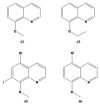New applications of old metal-binding drugs in the treatment of human cancer
- PMID: 22202066
- PMCID: PMC3646510
- DOI: 10.2741/274
New applications of old metal-binding drugs in the treatment of human cancer
Abstract
Significant advances in the use of metal complexes, precipitated by platinum, have fostered a renewed interest in harnessing their rich potential in the treatment of cancer. In addition to platinum-based complexes, the anticancer properties of other metals such as ruthenium have been realized, and ruthenium-based compounds are currently being investigated in clinical trials. Since the process of drug development can be expensive and cumbersome, finding new applications of existing drugs may provide effective means to expedite the regulatory process in bringing new drugs to the clinical setting. Encouraging findings from laboratory studies reveal significant anticancer activity from different classes of metal-chelating compounds, such as disulfiram, clioquinol, and dithiocarbamate derivatives that are currently approved for the treatment of various pathological disorders. Their use as coordination complexes with metals such as copper, zinc, and gold that target the ubiquitin-proteasome pathway have shown significant promise as potential anticancer agents. This review discusses the unique role of several selected metals in relation to their anti-cancer properties as well as the new therapeutic potential of several previously approved metal-chelating drugs. In vitro and in vivo experimental evidence along with mechanisms of action (e.g., via targeting the tumor proteasome) will also be discussed with anticipation of strengthening this exciting new concept.
Figures






References
-
- Wong E, Giandomenico CM. Current status of platinum-based antitumor drugs. Chem Rev. 1999;99(9):2451–66. - PubMed
-
- Eckhardt S. Recent progress in the development of anticancer agents. Curr Med Chem Anticancer Agents. 2002;2(3):419–39. - PubMed
-
- Abrams MJ, Murrer BA. Metal compounds in therapy and diagnosis. Science. 1993;261(5122):725–30. - PubMed
-
- Galanski M, Arion VB, Jakupec MA, Keppler BK. Recent developments in the field of tumor-inhibiting metal complexes. Curr Pharm Des. 2003;9(25):2078–89. - PubMed
-
- Galanski M, Jakupec MA, Keppler BK. Update of the preclinical situation of anticancer platinum complexes: novel design strategies and innovative analytical approaches. Curr Med Chem. 2005;12(18):2075–94. - PubMed
Publication types
MeSH terms
Substances
Grants and funding
LinkOut - more resources
Full Text Sources

